New York State Failed to Deliver on Housing — New York City Must Step Up
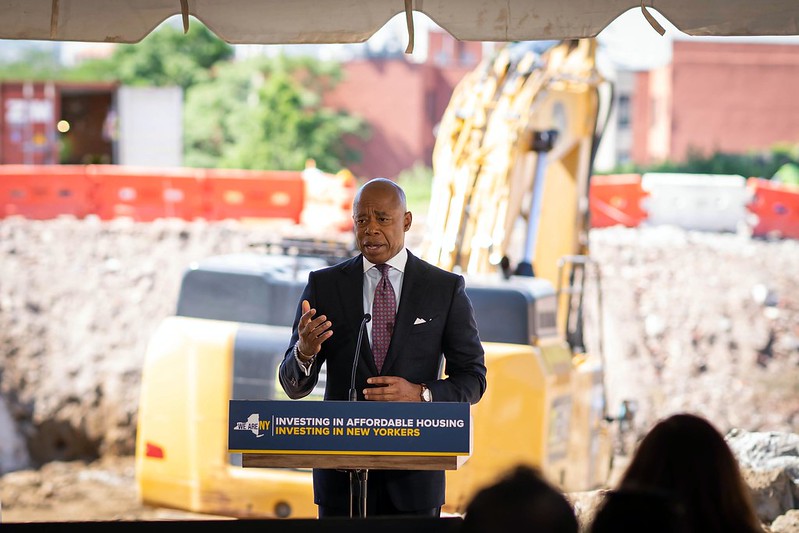
Mayor Adams talks housing (photo: Ed Reed/Mayoral Photography Office)
Once upon a time - also known as January 10 - Governor Kathy Hochul presented her vision for New York State. The centerpiece of her agenda was her New York Housing Compact, the most aggressive and ambitious plan to tackle the housing crisis in recent memory. The compact had flaws — tenant protections and affordability benchmarks were largely absent in the proposal. But the plan to mandate municipalities increase their housing supply and a target goal of building 800,000 units in a decade were right on track. They are appropriate positions to meet the needs of solving our housing crisis head-on.
But four months later, the compact is still only a proposal, as both houses of the State Legislature refused to come to agreement on its key components during state budget negotiations. The only real push in recent memory to address New York’s housing shortage has at best been stalled, and any major efforts from Albany to address the housing crisis will likely not happen until next year, and that is no guarantee.
But this does not mean nothing can be done to solve our housing crisis this year. Just because state government was unwilling to address the housing crisis does not mean New York City Hall has to sit idly by and concede defeat. With the state's inability to deliver solutions, now is the time for New York City to step up and act on its initiatives to address our crippling housing shortage and rising rents. Fortunately, there are positive signs from city leaders and a handful of proposals in the offing.
Hochul’s goal to produce 800,000 units of new housing statewide in the next decade might be on pause, but Mayor Eric Adams’ benchmark of 500,000 new units of housing in New York City in that time is still alive. The mayor’s effort is in part reliant on state action that is not yet happening, but there is still a good deal the city can control.
It is a high bar to clear, as it would be the highest rate of housing production since the 1920s — but with the supply shortage in the city, a bar of that caliber is necessary. In December, the Adams administration outlined this vision in his Get Stuff Built plan, with over a hundred proposals designed to speed up and streamline housing construction. These proposals — from expediting the pre-certification process for rezoning applications to adjusting the environmental review process and standards — are necessary to get more housing in the pipeline and to make new housing production feasible.
With his Get Stuff Built plan, the City of Yes: Housing Opportunity zoning text amendment in development, and more, Mayor Adams has meaningful housing initiatives in his arsenal. Given the state taking a back seat on housing, these plans are needed more than ever. Adams should move aggressively to push these proposals, as well as initiating additional neighborhood rezonings — something that he has been rather quiet on in his tenure.
Mayor Adams is not the only one to pitch aggressive proposals, and he should take up willing partners. Manhattan Borough President Mark Levine has identified more than 170 sites across Manhattan to redevelop for housing as well as 9 sites for rezoning to accommodate more housing stock, which he says would result in 73,000 new units of housing. His plan was so popular that instead of the backlash he may have expected, Levine received suggestions from residents pointing to additional locations they thought new housing should rise.
Levine has provided a framework for every borough president to address housing shortages in their borough, and while none has yet to perform the same type of study, several others have professed their commitment to housing growth and are taking steps toward making it happen.
Even a couple of community boards have jumped on the trend of standing for more housing — an encouraging sign, considering the track record of community boards being hostile towards new development. Manhattan Community Board 4 released a proposal that would inject tens of thousands of new housing units. And Manhattan Community Board 2, which had previously opposed the SoHo rezoning, implied that it wants to see an increase in the size of 388 Hudson Street, a 100% affordable housing development in the West Village.
For progressive legislators, one of the sticking points of the governor’s Housing Compact was its lack of tenant protections. Fortunately, a handful of tenant provisions are floating around City Hall, and already enacted measures are ripe for reinforcement.
The Fair Chance For Housing Act is currently before the City Council; it would bar landlords from discriminating against prospective tenants with criminal background checks, giving many more people, especially people of color, a better chance at good and stable housing. There are also existing programs, like Right to Counsel, experiencing chronic funding issues. Without the proper funding for Right to Counsel, eviction cases and vulnerable tenants slip through the cracks. Patching those holes could provide many vulnerable tenants fair representation in court and the opportunity to stay in their homes.
While the State Legislature might be content with the status quo, the conversation around housing is changing in the city, and the seeds for meaningful improvement already exist. More aggressive action is needed, but there are several proposals that form a good start. Now is the time that ideas, proposals, and goals to alleviate the housing crisis must be turned into action.
But there is little by way of tangible legislation where it is needed. Despite many city leaders endorsing the Housing Compact, not much pressure has been applied to implement local solutions. Mayor Adams must quickly move his housing plans into action and show the public the results along the way, continuing to build support for advancing solutions. The City Council should also move to protect current and prospective tenants, implement the fair housing framework recently released by Speaker Adrienne Adams and Council members, and ensure that the next city budget includes essential funding for housing in many avenues, from affordable housing subsidies to tenant vouchers to staffing at key agencies.
It is important to remember that all the solutions the city could pass will not be enough. The lack of tenant protections is a fair critique, but Hochul’s Housing Compact offered a chance at real progress. Albany has the power to make sweeping changes to make it far easier for municipalities to solve the housing crisis.
That includes the broader planks of Hochul’s plan to require housing growth everywhere, especially around mass transit hubs, but also important specific policies like eliminating the Floor Area Ratio (FAR) cap on residential development in the city and legalizing accessory dwelling units. The lack of these policies will continue to hamper our ability to add much-needed supply to our housing stock.
The spotlight was shone brightest on the suburbs and vocal resistance to the plan, but New York City’s zoning landscape would have seen major changes too. While Hochul has said she will continue to fight for a housing plan in the future, advocates must continue to push for holistic changes at the state level. But it would be a tremendous disservice to vulnerable tenants and prospective residents if the city continues to wait for Albany to flip the switch.
Rents are still rising and flirting with records, the Rent Guidelines Board is considering significant increases on rent-stabilized apartments, more people cannot afford their rent comfortably, and housing construction is slowing. Even if City Hall is acting with one hand tied behind its back, our leaders need to do everything they can to keep people in their homes and get new homes built. The one hand the city does have accessible can still make meaningful changes to reverse these trends.
City leaders endorsing the Housing Compact is a good sign, but they cannot simply pass the buck to Albany or throw up their hands about the lack of state-led progress. As the old saying goes, If you want something done right, do it yourself.
***
Austin Celestin is a rising senior at New York University studying Urban Design and Journalism.
***
Have an op-ed idea or submission for Gotham Gazette? Email This email address is being protected from spambots. You need JavaScript enabled to view it.
Plunge in New York Tax Receipts Could Foreshadow Budget Deficit Just as Fiscal Year Begins

Gov. Hochul talks budget (photo: office of Governor Hochul)
Governor Hochul and the New York State Legislature finished passing the 2023-2024 state budget on May 3, about a month after the April 1 start of the fiscal year. The budget includes generous increases in funding for schools, health and mental health care, the MTA, and more. The budget is, of course, intended to be balanced, but a New York State Comptroller April 2023 cash report, issued May 16, showed a major plunge in April tax receipts from the prior year, raising concerns about a developing budget deficit for this fiscal year as it’s just beginning.
The report comes early in the new fiscal year and includes tax returns filed by April 15, showing a 49% drop in income tax revenue compared to April 2022, falling from $14 billion to $7 billion.
Another report from Comptroller Tom DiNapoli’s office, released May 18 on the enacted state budget, says that April tax collections overall (including sales, corporate, and other) were $4.4 billion below predictions issued by the State Division of the Budget (DOB) just a few months ago.
The DOB had already forecast a drop in collections compared to April 2022, but the actual collections were still 39% below forecast. There is no official prediction yet of a sudden large deficit opening up in the state budget, but these numbers and other indicators tell me a big hole is highly likely.
The Comptroller’s analysis of the decline offers insight into why a deficit may have already opened, with this statement (my underline) on page 8 of the report:
“Although only a month into the new fiscal year, April tax collections may be a cause for concern, particularly in relation to the PIT [Personal Income Tax]. A large share of April PIT receipts is related to the settlement of the previous tax year as the majority of taxpayers file their annual returns during the month. These settlement collections are not based on current economic circumstances but those of last year. For example, they reflect the overall decline in the financial markets which impacted taxpayers’ investment income, such as dividends, interest, and capital gains. According to reports from the Department of Taxation and Finance, the net settlement for the 2022 tax year totaled $3.6 billion, 66.3 percent lower than that for 2021.”
As the Comptroller report points out, the tax revenue reduction in large part related to taxpayers’ income from 2022. It is past income, not present or even recent income. The basis for income in 2022 must have included large declines in capital gains income, concentrated heavily among the wealthy and related to declines in the stock market in 2022. The S&P 500 fell 19% in 2022.
According to the most recent information from the State Division of the Budget, in 2020, the top 1% of New York taxpayers were 53% of total nonwage income (capital gains, dividends, etc.) and 46% of New York State income tax liability, meaning drops in their nonwage income have major effects on New York’s tax receipts.
One possible confirmation that New York is headed for deficits comes from California. The state government there has announced it has a $32 billion deficit for its budget scheduled for adoption on July 1, 2023, an immense swing from large surpluses. California adopts its budget several months later in the year than New York, meaning it is getting more information about its tax receipts now than New York relied upon several months ago when it built the assumptions for its own budget. California’s economy suffered from major climate impacts in 2022, which is part of that story. California’s tax system, however, is similar to New York; its wealthiest taxpayers make up a large portion of the state’s tax revenue, and can be significantly affected by swings in the stock market.
A New York deficit of $4.4 billion would not provoke an immediate crisis because the State’s operating budget using State funds is $127 billion a year (of the $229 billion budget for the new fiscal year, which includes a lot of federal funds). The State has immense reserves, pegged initially at $19.5 billion, due in part to a surplus in the last fiscal year of nearly $9 billion, according to the last DOB update before adoption.
There is no evidence in New York that the current economy is declining; sales and corporate income tax receipts in April were normal, and withholding tax receipts from currently employed people did not decline. The State can backfill a deficit from its reserves.
A budget hole, however, could seriously exacerbate the State’s long-term challenges because budget forecasts project large deficits in the next three years, 2025-2027. State DOB budget gap forecasts are based on projected revenue and spending: in balance in 2023-2024, but deficits of $5 billion in 2025, $8.5 billion in 2026, and $7 billion in 2027 (see p.95 of the Updated New York Executive Budget, March 2023).
The State’s Financial Plans anticipate using its $19.5 billion in reserves to help cover those deficits in coming years, and those deficits add up to over $20 billion. But if the State needs reserves to cover even a $5 billion deficit this year, it will run out of its reserves that much more quickly. Any new weakness in New York’s economy will accelerate the State’s deficits.
After Governor Hochul issued her proposed budget, the Legislature’s own plans would have added $4 billion in spending above her budget. The Governor and the Legislature finalized the budget with only an extra $2 billion above the Governor’s proposal. The Governor deserves credit for getting the Legislature to exercise some restraint on spending, especially now that the risks of a hole in the budget are so substantial.
It may be some months before the Governor and the State Division of the Budget acknowledge a current-year deficit. There will be enough money this year to cover it, barring a disaster. I was in the Legislature in 2008 when then-Governor David Paterson called us back in December of that year to address an $18 billion deficit that had opened in New York’s budget as the Great Recession began. Let’s hope nothing comparable happens this time.
***
Jim Brennan was a member of the New York State Assembly for 32 years, where he chaired four committees. On Twitter @JimBrennanNY.
***
Have an op-ed idea or submission for Gotham Gazette? Email This email address is being protected from spambots. You need JavaScript enabled to view it.
This AAPI Heritage Month, Let’s All Take a Closer Look at Mental Health Care in Our Communities
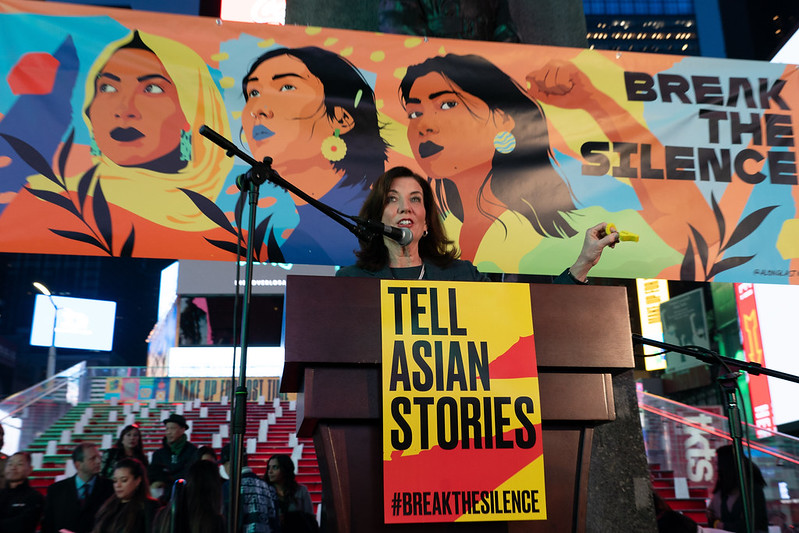
"Tell Asian Stories" (photo: Don Pollard/Governor's Office)
As Asian American and Pacific Islander (AAPI) women, May is a month of celebration. It is also a time to highlight Mental Health Awareness and commemorate Mother’s Day. But while many of us are celebrating, some are coping with a gaping void left by those who died by suicide in the past year.
Though updated suicide statistics for 2022 are not yet available, we’ve seen the stories reported by community media outlets of individuals in our community who are no longer with us. It’s all heartbreaking.
Take Flushing, Queens, where Asians make up more than 70% of the population. At least four high-profile Asian women have died by suicide in the neighborhood since last May. What’s even more tragic is that family members or friends of most of them told the media that these individuals had shown some signs of distress before they were swallowed up by despair. As we know, these tragedies are often preventable if they had received proper care. But finding those necessary resources is not always easy for Asian American and immigrant women.
Statistics and studies, although far from extensive, have shed light on AAPI women’s critical needs for mental health services through the years. For example, data from the U.S. Department of Health and Human Services’ Office of Minority Health shows that suicide was the leading cause of death for Asian Americans aged 15-24 in 2017-2018, and Asian American girls, in grades 9-12, were 20% more likely to attempt suicide compared to their white peers.
An annual survey released by MetroPlusHealth this month sounds another alarm. The latest data from the city-owned affordable health insurance entity finds that Asian women face greater mental health risk than many others. Despite recent attention on anti-Asian violence, 41% of respondents had been called a racial slur in the past year. This prejudice was not only from strangers. For example, 48% of participants said they have encountered racial discrimination in the workplace, almost double the average for women citywide.
With the backdrop of these devastating statistics, there is a positive note – Asian women have gained a greater awareness of mental health issues. The vast majority of respondents, 77%, said they would encourage their family members and friends to seek professional mental health services, 10 percentage points higher than last year. While 84% agreed that talking to a mental health professional would positively impact their life, 16 percentage points higher than the previous year.
However, whether higher risks and greater awareness can transfer to obtaining help successfully is another story. The survey finds only 45% of Asian women said they know a community-based organization providing mental health services in their preferred language. The importance of linguistic and cultural competency in mental health services for immigrants and immigrant communities cannot be emphasized enough. How do you explain your sadness or trauma in your native language? How do you express and accept affection when it is not a cultural practice?
The solutions are coming from community groups and healthcare providers who lower the difficulty of seeking help. To close the language gap, the Asian American Federation created a mental health directory serving nearly 18,000 people with a list of in-language professionals in various neighborhoods throughout New York City to ensure every Asian New Yorker who needs mental health care is able to receive it in the language they are most comfortable speaking.
While providing access to professionals is a priority, we must also work towards more transparent conversations at home. In traditional Asian families, regular usage of the word “love” is unusual, and the term “mental health” simply doesn’t exist in many Asian languages and dialects — and when it does, the counterpart often carries significant stigma. This is where representation can make an impact.
The AAPI community has a long road ahead of us in tackling the mental health gap. For us, perhaps the journey can start this month with some simple steps. Hug your mom, tell her you love her and ask how she’s feeling. Open the lines of communication that normalize expressions of affection and care. It is also our hope that more people in broader society will work towards language inclusivity and accessibility to make mental health resources more equitable. That way, next May and thereafter all Asian grandmothers, mothers, and daughters who should be here to celebrate will be here.
***
Luna Liu is marketing manager of MetroPlusHealth, a New York City-based nonprofit health insurance company. Jo-Ann Yoo is executive director of the Asian American Federation. On Twitter @MetroPlusHealth & @AAFederation.
***
Have an op-ed idea or submission for Gotham Gazette? Email This email address is being protected from spambots. You need JavaScript enabled to view it.
Endangered Species Day: How New Yorkers Can Help Heal the Animals, Heal the Earth

Animal awareness (photo: John McCarten/NYC Council)
May 19 marks Endangered Species Day, a time when people around the world focus on animals who are in grave danger of becoming extinct or soon endangered.
This year is especially poignant, as it also marks the 50th anniversary of the Endangered Species Act — landmark legislation conserving wildlife, fish, and plants, as well as habitats.
Even New York City is home to two species of wildlife that are considered endangered or vulnerable. The impossibly cute and endangered piping plover bird, with its round body, tiny size, and charming features, has recently seen a resurgence on New York City beaches thanks to the efforts of wildlife conservationists and concerned citizen volunteers. Horseshoe crabs are a familiar sight along the beaches of Brooklyn, but many do not know that these crustaceans are considered vulnerable on the IUCN List of Threatened Species. Both of these species face pressures from habitat loss and destruction, as well as human disturbance.
I hope you will find inspiration to take action during this day, celebratory month, and beyond — because the stakes have never been higher and consequences more dire, for wildlife and for humans, too.
Our leading scientists say we are at a crossroads, facing potential catastrophic damage to ecosystems with loss of biodiversity around the globe reaching crisis levels, according to this year’s report by the United Nations’ Intergovernmental Panel on Climate Change.
Animal populations have declined by nearly 70% in the last 50 years due to the compounding effects of human activity, including overhunting and exploitation of animals, habitat destruction, and environmental pollution.
United Nations Secretary-General António Guterres captured the situation well when he said, “humanity has become a weapon of mass extinction” during opening remarks for the most recent global biodiversity summit.
The good news is we still have time to choose protection over destruction; to shepherd in a new era of respect for all animals as we share the same destiny driven by human actions.
As the New York state director for the nonprofits Animal Wellness Action and Center for a Humane Economy, and a resident of Brooklyn, I am part of several current campaigns and hope one or more may be of interest, because there is no better time to step up and be a part of promoting the health of animal lives. There is so much needless cruelty done to animals that is harming not just our human souls, but the web of life that defines the planet as a whole. If we heal the animals, we heal the Earth.
Get the Lead Out of Our Wildlife
Nearly half of our bald and golden eagles are suffering and many dying just this past winter from toxic levels of lead — one of the most dangerous pollutants causing adverse effects on wildlife today and potentially harming population growth and leading to extinction of sensitive species. You can help. Learn about the dangers of lead ammunition and fishing tackle left in the environment and food chain.
Protect Apex Predators to Boost Biodiversity
Science tells us quite clearly that our top predators — wolves, mountain lions, and bears — serve key ecological roles in safeguarding biodiversity. According to one study in Mammal Review, “Large, terrestrial carnivores are key regulators exerting strong and irreplaceable effects on biological community assemblages, and their absence can lead to fundamentally downgraded ecosystems.” Instead of wiping them out, as humans have done throughout history, we need to respect and protect them. Learn more about how to help.
Mass Killing is Not Conservation
Independent scientists and academics are rightfully concerned that the largest massacre of land mammals on the planet today — the inhumane slaughter of kangaroos in the wild — is putting wildlife at risk. My organization has been wildly successful at convincing two of the leading three sport shoe manufacturers — Nike and Puma — to stop sourcing kangaroos as material to make soccer cleats. Tell Adidas that it too must stop supporting the largest massacre of land mammals on the planet today.
Factory Farm Pollution Touches Us All
Besides being cruel, industrialized factory farming has caused irreparable harm to healthy ecosystems and wildlife by polluting our air, water, and land. You can take part in meaningful reform by telling your Congressional representatives that they can stop the inhumane confinement of pigs in gestation stalls. And help to end the hyperproduction of dairy cows by telling your legislators to provide a simple choice of soy in our nation’s public school cafeterias.
All New Yorkers can feel good about their experiences and engagement during this year’s Endangered Species Day and beyond.
***
Susan Stork is New York State Director of Animal Wellness Action. On Twitter @awaction_news.
***
Have an op-ed idea or submission for Gotham Gazette? Email This email address is being protected from spambots. You need JavaScript enabled to view it.
The QueensWay is Good for Students and Learning; Let’s Get It Built

Queensway rendering (Trust for Public Land)
As Co-Principals of the Metropolitan Expeditionary Learning School (MELS) in Forest Hills, Queens, we place learning through outdoor experiences at the heart of our curriculum. We send our students out across the city and beyond, bringing in experts to give science, history, and other subjects real-life relevance.
Frustratingly, there’s a huge, unused outdoor classroom sitting right in our backyard. Bureaucratic indecision has stymied progress on turning the QueensWay, a railway line abandoned 60 years ago, into a thriving park.
It has now been a dozen years since we, ourselves, first got involved in intensive community discussions about it. We engaged a now-adult generation of former MELS students in shaping the future of the project together with many members of the local community.
Mayor Eric Adams did recently announce $35 million for the first phase of QueensWay. It’s for a section that adjoins our property and comes right up to the back of our school.
In the years since that past generation of our students first got involved in conversations about the future of the project, they’ve grown up, gone to college, and are now living productive adult lives. We, meanwhile, may have a few more gray hairs, but we haven’t given up hope on the tremendous potential of the QueensWay as an essential part of our students' learning experience. We’re glad the next generation of our students will get to benefit from the project while they’re still at school with us. It can’t happen soon enough.
The new entrance will give our students quick, safe access to the Forest Park area without having to walk across Union Turnpike, which is busy, has a small sidewalk, and is not conducive for large groups of students to safely walk. It will also give safe access to our school for many of our students who come from adjoining neighborhoods and currently have to cross other busy, wide, and dangerous roads like Woodhaven Boulevard and Metropolitan Avenue. The QueensWay is a safer option and connects neighborhoods and subway stops.
The outdoor classroom portion of the QueensWay will provide a unique opportunity for students to learn about the environment, sustainability, and urban design. We believe the project has the potential to inspire the next generation of environmental leaders, as well as landscape architects, scientists, gardeners, and so many other career pathways.
Our students will be able to explore the QueensWay and its unique mature forest of 60-year-old trees to learn about the plants and wildlife that call New York City home. They will also be able to learn about the history of the space and the communities that have used it in the past, as well as its current benefits of providing shade during hot summers and absorbing stormwater.
The QueensWay also offers a unique opportunity for our students to learn about the impact of human activity on the environment. By studying the QueensWay, our students will be able to see firsthand the effects of pollution, climate change, and other environmental challenges. It will help them understand the importance of sustainability and the need to take action to protect our planet.
The QueensWay will provide a space for our students to engage in experiential learning. They will be able to participate in service projects, such as planting trees, cleaning up litter, and improving the habitat for wildlife, ideally designing and caring for natural spaces that are directly connected to our school campus and to apply their learning in an authentic real-world format. These projects will help our students to develop a sense of responsibility for the environment and a commitment to making positive change in their community.
Finally, the QueensWay project offers an opportunity for our students to connect with the wider community. The QueensWay will be a public space that is open to all, and our students will be able to interact with people from different backgrounds and communities. This will help to foster a sense of community and understanding among our students, and it will help to build bridges between different communities in Queens. Let’s get it done.
***
Hillary Mills and Damon McCord are Co-Principals at the Metropolitan Expeditionary Learning School (MELS) in Queens.
***
Have an op-ed idea or submission for Gotham Gazette? Email This email address is being protected from spambots. You need JavaScript enabled to view it.
It’s Time for New York State to Finally Address Our Literacy Crisis and Ensure All Kids Can Read
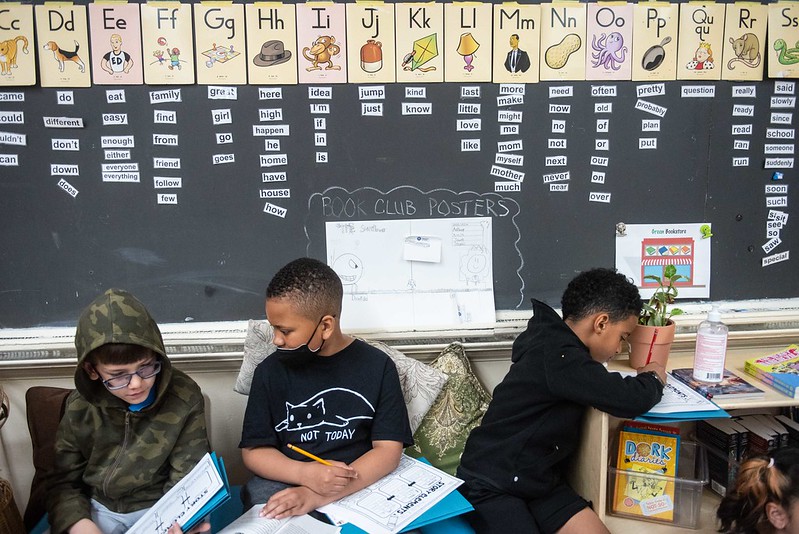
Kids at school (photo: Michael Appleton/Mayoral Photography Office)
The literacy rate amongst children is at a crisis level: two-thirds of fourth-graders nationwide are unable to read proficiently. This represents a complete failure to prepare our students for the most basic of life skills, in part due to the continued use of flawed literacy instruction methods.
New York’s proficient reading rates of 30% are even worse than the national average. While other states are taking significant steps to address the crisis, New York has not acted, still permitting teaching practices that have been thoroughly debunked, rather than those aligned with the science of the reading brain.
New York is also failing its teachers. Our teachers-in-training and current educators are not properly instructed on how to teach reading. School districts continue to use harmful curricula, including debunked “three cueing” strategies that emphasize looking at pictures and guessing the words. A whopping 75% of K-2 and elementary and special education teachers use three cueing despite decades of data proving it’s ineffective.. The vast majority of our colleges of education are training future teachers how not to teach kids to read.
We know what works and simply have to stop using what doesn't. Children can and must be taught to understand and recognize letters and the sounds they make, so they can decode the words they encounter, and put words together to form sentences.
The 2000 National Report on Reading identified the five pillars of literacy instruction fundamental to teaching children how to read successfully. These pillars – phonemic awareness, phonics, fluency, vocabulary, and comprehension – underpin the language-based approach to instruction that is referred to as “structured literacy.” It emphasizes highly explicit and systematic teaching that has been proven successful in building literacy. This approach is even more critical to reaching kids with dyslexia and related learning disabilities. And here’s the thing: the brain research confirms it.
Mayor Eric Adams and the New York City Department of Education (DOE) recently announced the biggest overhaul to reading instruction in the public school system’s history, set to begin this fall. This initiative will require city schools to select one of three curriculums that follow the science of reading. This is a promising step, and the state should follow this lead.
This week, students, families and educators gathered in Albany again to urge the State Legislature, the State Education Commissioner, and the Governor to address these issues. We held our 8th Annual Dyslexia Awareness Day at the Capitol to share personal experiences and champion legislation to combat this literacy crisis.
One such solution is my “So All Can Read” bill to train future teachers in the science of reading. A recent report by the Education Trust - NY revealed that a major barrier to resolving this persistent problem has been the failure of our colleges of education to align their instruction with the science of reading. Other legislative solutions include a bill to screen incarcerated individuals for dyslexia and a dyslexia task force.
Inaction has consequences. Reading scores for Black, brown, and low-income students are even lower than the national average. Students who do not reach a fourth grade reading level are more likely to drop out of high school, be unemployed, live in poverty, or face incarceration. Serious policy changes are needed or we risk continuing to leave our children behind and fueling the school-to-prison pipeline.
***
Assemblymember Jo Anne Simon is a former teacher of deaf students (which requires language-based approaches), won a landmark disability rights case to secure testing accommodations for an individual with dyslexia on the NY Bar Exam, and served as president of the NY Branch of the International Dyslexia Association (now called Everyone Reading). On Twitter @JoAnneSimonBK52.
***
Have an op-ed idea or submission for Gotham Gazette? Email This email address is being protected from spambots. You need JavaScript enabled to view it.
How STEM Education Will Unlock New York’s Sustainable Future
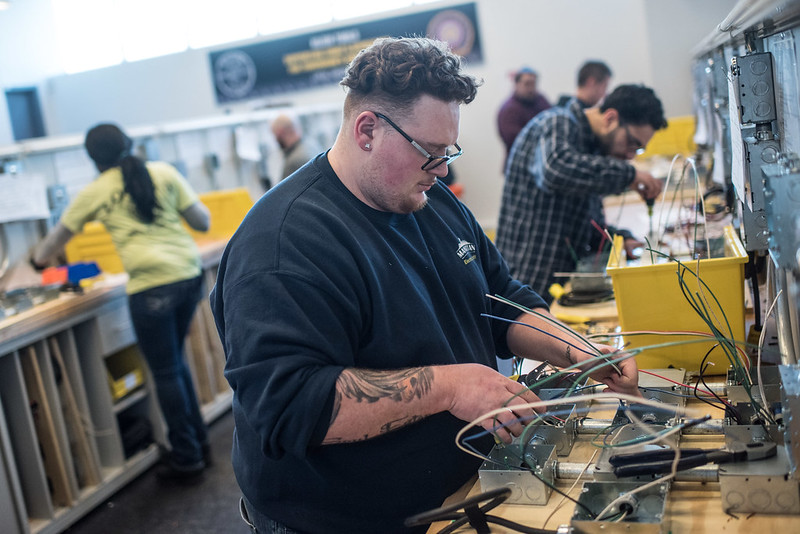
Hands-on learning (photo: Michael Appleton/Mayoral Photography Office)
Here in New York, with 520 miles of coastline in New York City alone, we understand the urgency to address climate change and the need to act now. Today, the question is how do we achieve a successful and just transition to a decarbonized world?
The transition to a green economy is underway all over the country through advancements and growth in renewable energy. But, maintaining these energy systems will require a highly trained and educated future workforce with the skills and knowledge necessary to sustain and innovate mass change at scale, in ways that facilitate equitable opportunity and environmental justice.
Focused investment in interdisciplinary STEM education that connects to students’ lived experiences is a winning strategy to ensure we’re preparing for the workforce needs of a sustainable future.
Early exposure to STEM subjects produces impressive outcomes. Studies have shown that students who receive a STEM education are more likely to pursue higher education and careers in STEM-related fields lead to higher earning potential and greater job stability. Further, research demonstrates the effectiveness of hands-on place- and project-based learning for increasing students’ positive attitudes, levels of engagement, and confidence.
When schools teach through a sustainability lens to inspire student-driven projects, young people develop a stronger sense of agency to connect the dots across the environmental, economic, and societal dimensions of our shared challenges, with their action serving as a balm for their anxieties about the future.
In New York, the offshore wind sector alone is expected to catalyze billions of dollars in investment and create thousands of jobs over the next decade. This presents a unique opportunity to create pathways for young New Yorkers to become the professionals who will build and upgrade offshore wind farms for generations to come.
This community-changing economic opportunity starts in the classroom. Increasing access to place-based STEM education for students is essential to creating a robust and inclusive workforce capable of meeting the demands of the expanding offshore wind sector and representative of the communities it serves.
And we know: CELF is a nonprofit organization that works with K-12 teachers and students to advance environmental literacy through professional development and experiential learning. Our programs focus on teaching students of all ages about sustainability, social responsibility, environmental stewardship, and civic engagement, introducing them to conservation concepts and systems thinking skills from an early age through engagement and action in their communities. We are teaching real-world environmental sustainability concepts that are not often found in traditional K-12 classrooms but are critical to confront climate change.
Now we are ready to scale our approach to even more New York schools to equip students with the STEM skills and action competencies needed to build future careers in the green economy. That is why we have chosen to partner with Leading Light Wind – the only American-led offshore wind project in New York Bight, the offshore area.
Partnering with Leading Light Wind was an easy choice for us because of their commitment to educating and training the next generation of workers through partnerships with organizations such as the CUNY College of Staten Island, the CUNY Offshore Wind Advisory Network, the Brooklyn Navy Yard, Gotham Whale, the Waterfront Alliance, the New York City Economic Development Corporation, and others. Our partnership with Leading Light Wind will enable us to provide even more resources and opportunities to students interested in pursuing careers in the offshore wind industry.
As we move towards a clean energy future, it is imperative that we invest in bold plans that advance clean energy and that train, educate, and empower American workers and the local communities needed to get us there.
More cross-sector partnerships are critical to advance a holistic approach to combating climate change and building a clean energy future. From education to labor to environmental justice advocacy and more, we all must work together to increase equitable access to STEM education, provide training opportunities for students from all backgrounds, and support workforce development programs that will fuel a just energy transition.
Together, we can ensure that the region’s offshore wind sector is a catalyst for positive change, providing good jobs for workers and a brighter future for the region, and planet.
***
Tara Stafford Ocansey is Executive Director of the Children’s Environmental Literacy Foundation (CELF). On Twitter @TaraSOcansey & @CELFeducation.
***
Have an op-ed idea or submission for Gotham Gazette? Email This email address is being protected from spambots. You need JavaScript enabled to view it.
We Can Protect the Climate and Keep Energy Costs Down with NY HEAT
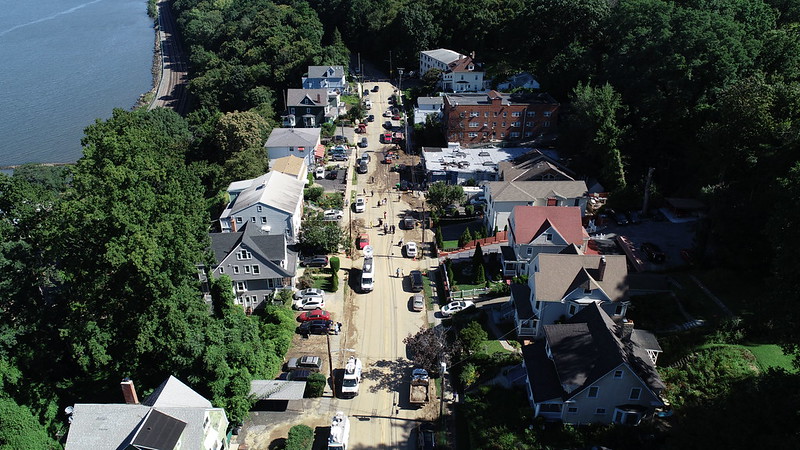
New York homes (photo: (Kevin P. Coughlin/Office of the Governor)
In March, the Intergovernmental Panel on Climate Change (IPCC) warned that the planet will cross a critical threshold for global warming within the next decade if we don’t take immediate action to curb emissions and meet ambitious climate mandates laid out in New York’s climate law.
As expected, gas utilities are casting doubt on the affordability of these needed reductions. Let’s be clear — New Yorkers and their families should not shoulder the burden of our clean energy transition.
Affordability is a major concern but we don’t need to weaken our nation-leading climate law to save the planet and save New Yorkers money. As the name suggests, legislation I sponsor with Senator Liz Krueger, the New York Home Energy Affordable Transition (NY HEAT) Act would help keep costs down for New Yorkers while accelerating our energy transition away from polluting fossil fuels and addressing affordability, keeping us on track to meet the goals of our climate law.
For decades, New Yorkers have been subsidizing the very infrastructure the gas industry’s profits rely on. The industry’s business models are premised on the perpetual taxpayer-subsidized expansion of gas infrastructure and services. Currently, due to the 100-foot rule mandate – which requires gas utilities to hook up all new customers to gas lines at no charge – ratepayers are footing the $200 million annual bill for this continued expansion of polluting gas infrastructure.
The NY HEAT Act (A4592/S2016) will relieve us of the hook-up cost, and stop the continued expansion of the gas system that is moving New York further away from the goals of the climate law. Thankfully, utilities like National Grid are already adapting and adjusting: as New York considers legislation like NY HEAT, the company is looking to sell parts of its pipeline network to meet future clean energy demand. Last year, it sold a majority share of its gas distribution business in the United Kingdom.
The savings don’t end there. For low- and middle-income families, NY HEAT would put a price cap on electricity bills, to limit paying no more than 6% of income to stay warm and cook dinner.
NY HEAT clears a path for utilities to build renewable thermal energy networks instead of replacing and expanding the gas network. Doing so will create thousands of new clean, green energy jobs for union pipefitters and electrical workers for decades to come. It could also prevent the billions of dollars of spending on replacement pipes that gas utilities are planning by 2040 and gas customers would get stuck paying for in the decades to come.
New York’s electrical grid maintains a surplus of energy that will support new, all-electric construction. While gas furnaces on the market today require electricity to power their electronics and fans, there are new technologies that keep electric equipment like heat pumps running when the power goes out.
The gas industry wants to prevent alternative options for a reliable, affordable, and green transition. Unsurprisingly, they were a force behind the recent unsuccessful push to undermine New York’s climate law – which would have enabled the combustion of more gas, for longer.
Our climate plan was years in the making. It was created in consultation with multiple expert advisory panels, subject to public hearings, and incorporated tens of thousands of New Yorkers’ comments. New Yorkers know that we can get off gas and have affordable, reliable energy and a stable climate — but that will take ratepayer funds currently used for expanding fossil fuel infrastructure to be reallocated.
If we want to save New Yorkers money and lead on climate, we must stop asking New York families to foot the $200 million per year bill to continue constructing and maintaining fossil fuel infrastructure that will inevitably become obsolete. As the Legislature continues its post-budget session, we must pass NY HEAT to move towards our clean energy future.
***
Assemblymember Patricia Fahy (D) represents the 109th District in the New York State Assembly, which includes the City of Albany, Town of New Scotland, and part of the Town of Guilderland. On Twitter @PatriciaFahy109.
***
Have an op-ed idea or submission for Gotham Gazette? Email This email address is being protected from spambots. You need JavaScript enabled to view it.
To Stop the Red Wave in Brooklyn, Democrats Must Invest in Young People
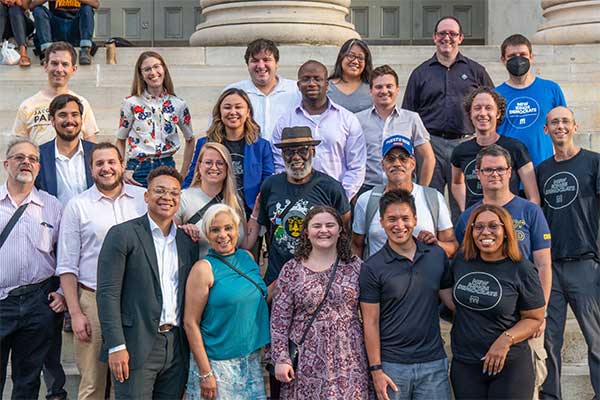
Brooklyn Young Democrats getting organized (photo: @BKYoungDems)
Last month, progressive and reform-minded Democrats celebrated two major wins in the Midwest. In Chicago, progressive Brandon Johnson beat several more conservative candidates in a hotly-contested mayoral election. In Wisconsin, Janet Protasiewicz beat out conservative Dan Kelly in a race for State Supreme Court, giving the court a liberal majority that could overturn the state's abortion ban and end the use of gerrymandered legislative maps.
In carving a path to victory, both Johnson and Protasiewicz relied on an often-overlooked but crucially important demographic: young people.
In Chicago’s mayoral runoff election, the Johnson campaign aggressively courted young voter organizations, and youth turnout in the mayoral runoff election jumped 32% from the initial vote in February. In Wisconsin, unprecedented turnout by college students helped push Protasiewicz to victory. This jump in youth voter participation and activism is part of a national trend: turnout among young voters for the 2022 midterm elections was the second-highest in 30 years.
As ostensibly-deep-blue Brooklyn still reels from a November red wave that flipped three Southern Brooklyn State Assembly seats to the GOP and led to the closest gubernatorial election in a generation, Democratic leaders could learn a thing or two from their counterparts in the Midwest and elsewhere.
One key lesson: to remain viable, the Brooklyn Democratic Party must invest in Gen-Z and Millennial voters and organizers.
The Brooklyn Democratic Party was largely absent during the competitive November elections, failing to provide support to vulnerable candidates despite the clear threat posed by Republicans. As early as 2020, our club, the Brooklyn Young Democrats, alongside Southern Brooklyn elected officials, had publicly and repeatedly warned that our party was losing ground in Southern Brooklyn. But despite the fact that we are the county party’s official youth arm, party leadership has spent the last three years not working with or investing in us but instead trying to de-charter and destroy us.
The Brooklyn Democratic Party’s failure to invest in young people extends beyond its lack of support for BYD. While our organization has mobilized to register youth and other voters in swing districts and to build up young political talent, there's no indication the Party has done the same, despite having substantially more funding.
That's a shame, because young people here are doing the work. During election season, BYD hit the streets, knocking on thousands of doors and making calls to voters. Just as in Wisconsin, young people in New York are leading the fight against workplace inequalities by unionizing Starbucks stores from deep blue Williamsburg to purple Bensonhurst. On the policy front, college students have led the charge for a New Deal for CUNY, and young housing activists recently protested the Rent Guidelines Board’s preliminary proposal to raise rents in the midst of a deep housing crisis.
The Brooklyn Democratic Party has been silent on these issues. That’s a sharp contrast from Chicago, where Johnson made education a galvanizing issue for young people by slamming his opponent Paul Vallas for Vallas’ role in privatizing Chicago schools, and where Johnson made strong commitments on the economic development and housing issues that drove young voters to the polls.
Young people represent an immense opportunity for Democrats: Millennial and Gen Z Americans will make up the majority of the electorate by 2028, and unlike past generations, we aren’t getting more conservative as we age. Youth voter turnout in New York has actually grown in recent years, but remains well behind two dozen other states, including those where Democrats made important inroads in 2022. To follow the lead of organizers in the Midwest and win legislative seats in Southern Brooklyn, our local Democratic party must empower the young people doing this work, not shut us down.
Across the country, Republicans' authoritarian tendencies pose an existential threat to democracy. We can fight back locally by making New York a beacon of democratic engagement and participation. As we prepare for competitive elections this year and next, the Brooklyn Democratic Party has two choices: embrace the energy of young Democrats and join us in that fight, or get left behind.
***
Hunter Rabinowitz is the President of the Brooklyn Young Democrats. Billy Richling is the club’s Communications Director. On Twitter @HuntRabinowitz, @billyrichling, & @BKYoungDems.
***
Have an op-ed idea or submission for Gotham Gazette? Email This email address is being protected from spambots. You need JavaScript enabled to view it.
Redefining Our Responsibility to Unhoused New Yorkers
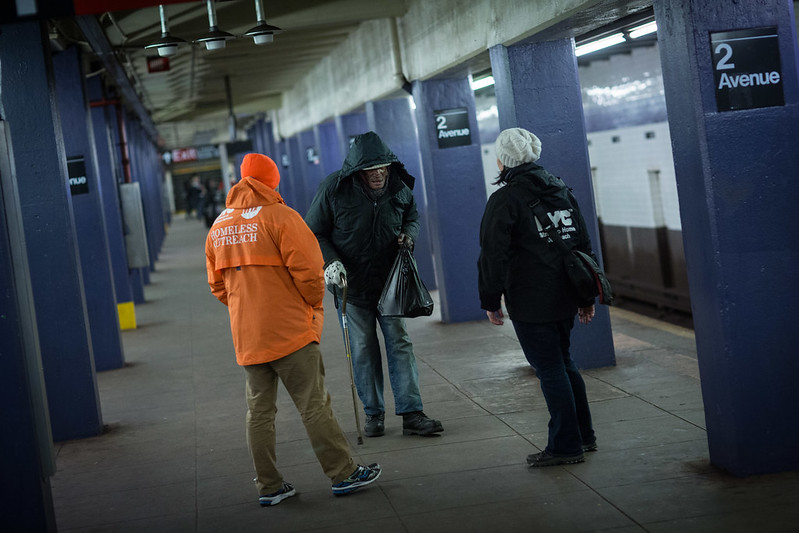
Subway outreach (photo: Michael Appleton/Mayoral Photography Office)
The recent death of Jordan Neely, an unhoused New Yorker living with mental illness, is a tragic reminder of the vulnerability of those living on the streets. It also raises critical questions for each of us to consider about our responsibility to our fellow New Yorkers. Homelessness is a policy failure, not a personal one. It's time we base our societal response around that fact.
For years, unhoused New Yorkers have been subject to stigmatization and criminalization by elected officials, the public, and the press. This portrayal of a marginalized community does not reflect reality. According to a study by the National Coalition for the Homeless, people living on the streets are much more likely to be victims of violent crime than they are to commit such crimes.
As advocates, there are concrete steps we can take to help.
First, it is time that we recognize people experiencing homelessness as a protected class and treat them as such. In New York State, there is pending legislation — The Homeless Protection Act (A2191,S6081) — which is being promoted by advocates with the lived experience of homelessness who want to be protected from acts of violence by those who hold malice against them and to end the stigma against people in their situation. Passing this law would mean an attack against a person experiencing homelessness motivated by bias could be treated as a hate crime.
Second, New York City government must provide adequate resources to social service providers that work with individuals in need.
As prices continue to rise, the Adams administration has chosen not to increase the funding it provides to a wide range of nonprofit organizations. Currently, the administration allocates $5.6 billion to support 4,600 human services contracts, which help people in various ways, including assistance for unhoused individuals. Unfortunately, instead of receiving additional financial resources to maintain their essential work in these challenging times, these nonprofits are being asked to cut their budgets, potentially making it more difficult for them to serve the communities that rely on their assistance effectively.
Organizations that provide emergency shelters, safe havens, and homeless outreach are among those being told they must cut their budgets by 2.5%.
At the same time, Mayor Adams neglected to provide a cost-of-living adjustment in his Executive Budget for the dramatically underpaid workforce that serves the New Yorkers with the highest needs.
This lack of financial support directly impacts the quality and effectiveness of services for people experiencing homelessness. With an already stretched-thin workforce, the absence of a cost-of-living adjustment exacerbates the homelessness crisis by reducing the capacity of service providers to address the needs of unhoused individuals.
This is the wrong time to cut costs and perpetuate underfunding for critical services; our neighbors and communities deserve better.
In memory of Mr. Neely and in solidarity with all unhoused New Yorkers, we must take decisive action to transform the way we address homelessness.
We must disrupt the culture that poses unhoused people as a threat. Passing the Homeless Protection Act is an essential step toward recognizing the dignity and rights of unhoused individuals.
We must urge the reversal of the detrimental budget cuts that will decimate vital services and outreach programs for those in need. A fully funded social safety net is crucial in building an inclusive, compassionate city we can all be proud of.
Let's call upon our leaders to stand up for change: create a culture of compassion, advocate for the Homeless Protection Act, and demand necessary funding.
***
Frederick Shack, LMSW, is CEO of Urban Pathways. On Twitter @UrbanPathwaysNY.
***
Have an op-ed idea or submission for Gotham Gazette? Email This email address is being protected from spambots. You need JavaScript enabled to view it.
The Housing Policies State Leaders Need to Focus on Accomplishing Now that the Budget is Passed

Housing (photo: Michael Appleton/Mayoral Photography Office)
New York State’s drawn-out budget process is finally done, but the largest issue in the minds of New Yorkers, housing, was virtually untouched.
Thousands of New Yorkers are struggling to find housing options they can afford, millions of square feet of commercial space sits empty, and more than 77,000 people live in New York City shelters, including more than 25,000 children. Fortunately, there are proposals that have received widespread support among the Legislature and other stakeholders when it comes to housing. They involve tools to support the conversion of empty offices to housing — including new affordable units in Manhattan.
State lawmakers have a moral imperative to support these measures before they wrap up this session — even if it means their summer vacation starts a little late. If they wait until next year to find solutions, the City will have to dig itself out of a far deeper economic challenge.
We are a third of the way through the decade and New York City is already well behind the lackluster housing production of the preceding two decades. That’s why we can no longer afford to let a select few Manhattan members of the Legislature from affluent areas use “progressivism” as a Trojan Horse to slip poison pills into housing policies — as we saw them attempt during the budget process.
Real champions of hardworking New Yorkers would be committed to constructive solutions to get housing built. They would work like hell to provide relief for the full half of New York City households who cannot afford to live here anymore, according to a recent study by the Fund for the City of New York and United Way of New York City. You would think they would look at the fact that at least 30% of those people’s incomes go to rent and feel compelled to get to “yes” on lifting the floor-to-area ratio (FAR) cap or expanding office-to-residential conversions. But instead, a select few have fear-mongered and blocked any prospect or opportunity for Black, Latino, and Asian people to move into their neighborhoods.
We have to be better and dream bigger. The warped view of perfect policies from those who have challenged these reforms has stopped the rest of us from getting anything done. The decadelong effort to keep the FAR cap in place has led to a mere 45,968 new units across Manhattan from 2010 to 2019, according to the Furman Center. That’s 10,000 fewer units created on the island than in the preceding decade – one in which two major crises temporarily slowed production. Such a downturn in production is a major reason why the average monthly rent in the borough has ballooned to $4,000.
Housing production in the 2020s has become even more anemic. Last year saw a mere 626 new projects filed with the Department of Buildings, according to data tracked by the Real Estate Board of New York. The 22 buildings that sought foundation plan approval last December represented a 90% drop from the same time a year earlier, signaling a lack of pro-housing policies has real implications.
It’s incorrect to say we’re barreling toward a crisis when we’re already in one, particularly when you consider the simultaneous explosion of commercial vacancies. Just recently, both the Wall Street Journal and The New York Times pointed to a potential economic strain worse than any we’ve seen before.
Let’s be clear: many Class A office buildings are still attractive. It’s why you still saw big commercial projects carry on through the pandemic. But Class B and C commercial space is underperforming overall, driving the historically high 16% commercial vacancy rate in Manhattan. There are serious implications the longer this goes on as real estate taxes account for the bulk of New York City’s revenue. Fewer tax dollars from empty properties means less money for the City in the years ahead, which translates to less money for schools, sanitation, mass transit, and other services New Yorkers depend on.
Lifting the FAR cap and expanding conversions, with an incentive to create affordable housing, are popular policies that Albany leaders can get done this year. No, they alone will not create the 800,000 units Governor Hochul has pledged to create to meet demand and allow growth. It would be a fool’s errand to hold out for a single, magic policy to deliver. What these measures can do, however, is create as many as 50,000 new housing units where they’re most needed – namely Manhattan.
There’s no other policy that’s united five borough presidents, nine community boards, dozens of advocacy groups, 32BJ SEIU, and elected officials at all levels of government. This is a proposal that’s united the Governor, the Mayor, and the City Council Speaker, as well as Council Members from across the political spectrum. When something looks this good, we shouldn’t let it slip by.
Our elected officials must stop using fear tactics to block good legislation and punt this into the next session. You can tell someone “Wait till next year” when their favorite team loses. But it’s cold comfort to someone about to lose their home or someone desperately looking for their first.
***
John Sanchez is executive director of the 5 Borough Housing Movement and a former Bronx community district manager. On Twitter @NYJohnSanchez.
***
Have an op-ed idea or submission for Gotham Gazette? Email This email address is being protected from spambots. You need JavaScript enabled to view it.